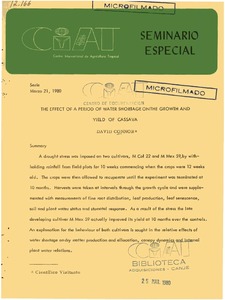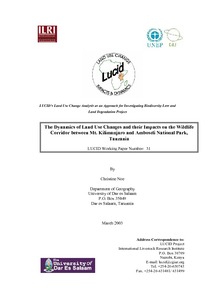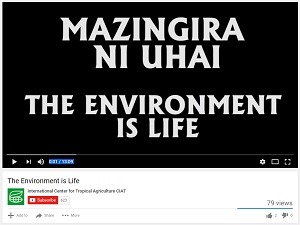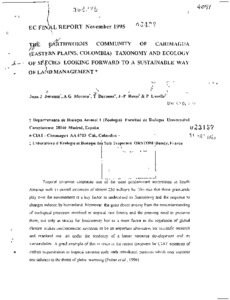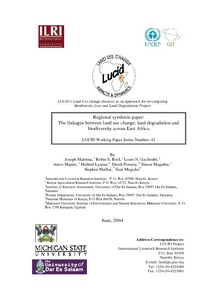uso da terra
AGROVOC URI:
The contribution of RADARSAT-1 SAR imagery to monitor land use in coastal areas of Costa Rica and Nicaragua
The effect of a period of water shortage on the growth and yield of cassava
Drought stress was imposed on 2 cassava cv. (M Col 22 and M Mex 59) at Santander de Quilichao (Colombia), by withholding rainfall from field plots (plastic covers were placed over the soil surface) for 10 wk, commencing when crops were 12 wk old. The plants were then allowed to recuperate until the expt was terminated at 10 mo. Harvests were taken at intervals through the growth cycle and were supplemented with measurements of fine root distribution, leaf production and senescence, soil and plant water status, and stomatal response. As a result of the stress, the late-developing cv.
The dynamics of land use changes and their impacts on the wildlife corridor between Mt. Kilimanjaro and Amboseli National Parks
The Environment is Life
This participatory video titled 'The Environment is Life' was filmed and produced by a group of 11 members from Mwangoi and Malindi villages Lushoto District, Tanzania. With this video, they want to communicate the message 'people should conserve and protect the environment so that they live a good and healthy life'. Through the film they demonstrate how they protect the environment, improve their yields, and the systems they use.
The earthworms community of Carimagua (Eastern plains, Colombia) : taxonomy and ecology of species. Looking forward to a sustainable way of land management?
Tropical savannas constitute one of the most predominant ecosystems in South America with an overall extension of almost 250 millions ha. The role that these grasslands play over the environment is a key factor to understand its functioning and the response to changes induced by humankind.
The evolution of swidden fallow secondary forests in Asia
Swidden agriculture in tropical Asia is a diverse practice, making it difficult to draw general conclusions on trends of the development of swidden fallow secondary forests (SFSF). There is, however, sufficient evidence to recognise trends of a gradual intensification often through the incorporation of extensive tree crop production in SFSF, or a direct conversion to intensive tree cash cropping. Factors contributing to the changes include emerging markets for cash crops or timber and pulp wood production, government policies and development projects, fire, and population pressures.
The Hesitant boom: Indonesia's oil palm sub-sector in an era of economic crisis and political change
Planted oil palm areas increased 20-fold and crude palm oil (CPO) production had a 12% average annual increase from 1967-1997. This conferred important economic benefits but threatened Indonesia's natural forest cover. Large-scale plantations displaced local communities and social conflict resulted. Early in the economic crisis, it was expected the boom would continue, and be propelled by currency depreciation and lifting of foreign investment constraints. However, there was a slowdown in area expansion and CPO production.
The Impact of sectoral development on natural forest conversion and degradation: the case of timber and tree crop plantations in Indonesia
This paper examines the conversion of Indonesia’s natural forests to timber and tree crop plantations, notably oil palm. The principal aims are to understand the impact of this process on natural forest and on forest-dwelling people, and to establish whether past and present policies governing this process are meeting their objectives.
The linkages between land use change, land degradation and biodiversity across East Africa
The role of pasture and soybean in deforestation of the Brazilian amazon
The dynamics of deforestation in the Brazilian Amazon are complex. A growing debate considers the extent to which deforestation is a result of the expansion of the Brazilian soy industry. Most recent analyses suggest that deforestation is driven by the expansion of cattle ranching, rather than soy. Soy seems to be replacing previously deforested land and/or land previously under pasture.



